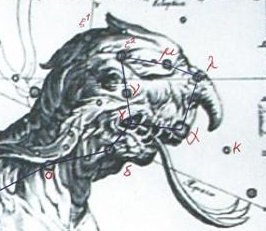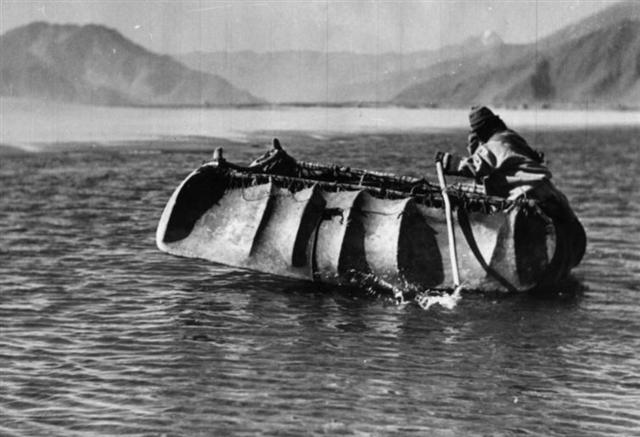Thus the Path of the God was like a Red Carpet (tapa mea) welcoming (carpe diem) the new Sun King at the edge of the year, at the reef between Sea and Land, at the rear of the old year: ... The Fijian barkcloth that in the end captures the chief represents his capture of the land: upon installation, he is said to hold the 'barkcloth of the land' (masi ni vanua). The barkcloth thus has deeper significance. In general ritual usage, barkcloth serves as 'the path of the god'. Hanging from the rafters at the rear, sacred end of the ancient temple, it is the avenue by which the god descends to enter the priest ... There is still more to the barkcloth. The barkcloth which provides access for the god/chief and signifies his sovereignity is the preeminent feminine valuable (i yau) in Fiji. It is the highest product of woman's labor, and as such a principal good of ceremonial exchange (soolevu). The chief's accession is mediated by the object that saliently signifies women ... Tapa 1. Side, corner, edge; he-hakarere a te tapa, to leave aside, to abandon; a te tapa mata'u o te haga, on the right-hand side of the bay. 2. Tapa mahute, piece of mahute material; this term is very common nowadays, but it seems probable that it was borrowed from the Tahitian in replacement of parehe mahute. Pare. Half raw, badly cooked. Parehaoga, food prepared in the earth oven (umu parehaoga) for a feast or for people whose help is needed for some work or for organizing a feast. Parehe, piece, bit; to fall, break into pieces. Parei, dirty, to have a dirty face and eyes, someone who gets up without washing. Parera, sea bottom. Vanaga. Ta.: Pare, a fort, a place of refuge. Ma.: parepare, a breastwork in a stockade. Mgv.: Pare, a covering for the head. Mq.: pae, id. Sa.: pale, id. Ma.: pare, id. Churchill. Parehe, to break, a crack. Parei, 1. (paré), dressed up. 2. To sparkle (of the eyes). Parera, 1. A shallow, a reef. 2. Deep water, profound, gulf; parera tai, deep sea; tai parera, high tide; hohonu parera, fathomless, unsoundable. 3. To lead astray. Hakaparera, to frighten, to scare. Pareu, skirt, apron. Mgv., Mq., Ta.: pareu, loincloth, apron. Pau.: Parego, to drown oneself. Ta.: paremo, drowned. Ma.: paremo, id. 3. To recount the years, the months; to recount happenings of many years ago, in verses called manu, in which a murderer confided his crime to his victim's relatives; the murderer himself asked a brother or a friend to compose those verses: e tapa koe itooku manu, compose my manu. The expression tapa ite manu was also used of a group of people expressing the desire to kill someone.
... The normal orientation of a glyph (when it is not left-right symmetric) is with its 'face' towards right. Time flows along with the text, and the events unfold from left to right, and it is only natural for the glyphs to 'look ahead'. The reversed 'persons', those who are looking back, can be imagined to have no future, as if they were very old people. This statement of mine is, though, just a help to remember what the sign of reversal means, viz. to show where the described events are ending. If not a full stop, then at least a comma.
4. Tagata tapa ta'u, according to traditions, this term referred to the scribes who recorded births on the tablets. Vanaga. 1. Border, fringe, edge, groin, cloth, clothing, dress, garment. Tatapa, lateral, bank. Tapatapa, edge. P Mgv.: tapa, the edge of the bast cloth, bast cloth in general. Mq.: tapa, fringe, cloth. 2. To name, to mention, to count, to calculate, to reckon, to number, to figure up, to recapitulate; tapa ki te igoa, to take a census; tapa igoa, list. Tatapa, to count, to number, to reckon. Tapatapa, to mention. P Mgv.: tapa, to give a pet name. Mq.: tapatapa, to recite, to invoke; tatapa, to take the name of some one, to announce by name. Ta.: tapa, to call by name. Churchill. Mq.: Tapaau, coconut leaf plaited to serve as a mat. Sa: tapa'au, a coarse coconut leaf mat. Tapatai, a dweller on the strand. Ma.: tapatai, beach. Churchill. Notably tapa also meant to count - presumably counting down to the arrival of the new Sun King. This we have remembered in our own custom to count to Christmas, i.e. to the 'top of the year'. Kapa¹, adj. Haw., rustling, rattling; s. cloth made of bark, cloth of any kind. Sam.: tapa, to beckon with the hand, to demand; s. the white border of a siapo; tapa-au, mat made of cocoa-nut leaf. Tong., tapa, id.; kapa-kapa, to flap with a noise as wings of birds. Marqu., tapa, bark cloth. Tah., tapa-ie, envelop in leaves; apa, the lining of a garment; apa-a, thick cloth made by men, not by the women; 'apa'apa, to flap as sail or the wings of a bird. Fiji., kava, a roll of sinnet; kaba, to climb. Motu (N. Guinea), kava, bark girdle for men. Biaju, tepoh, a mat. Salayer (Celebes), tupur, id. Malag., komba, a monkey. Kawi, kapala, a horse. Sanskr., kamp, to move to and fro, to tremble; chapala ('i.e., kampa-ala', Benfey), trembling, unsteady, giddy; châpala, quickness; kapi ('i.e., kamp-i', Benfey), a monkey. Perhaps kambala, a wollen blanket. Greek, καμπη, bending, winding, as a river, turn, trick, sudden change. A. Pictet (Orig. Ind.-Eur., i. 347-348) derives the Greek καβαλλης, a nag, and other kindred West Aryan forms for horse and its varieties, as well as καπρος, a wild boar, and caper, a buck, from the Kawi or obsolete Sanskrit application of the original sense, 'to tremble, rustle, flap', found in the Sanskrit kap, kamp, and the Polynesian kapa, tapa. Kapa², s. Haw., a bank, shore, side, as of a river, lake, wood, or the like. Rarot., tapa, id. Tah., apa'apa, one side of a thing when divided, the side of a house. Sam., tafa, the side of a hill; v. to turn on one side; tafa-fa, four-sided; tafatafa, the side; tafa-tasi, one-sided; tafa-to, perpendicular, steep as seen from above; tafa-tu, id., as seen from below. Marqu., tapa-hai, coral; kapa-i, on the side of the sea. Fiji., taba, wing, shoulder, branch, one side. Malg., taf, tafo, the roof of a house; tambon, above. Welsh, tab, tav, an extended surface, a spread; tob, top, top, crest; cop, summit. Irish, capat, head. Armor., kab, id. Lat., tabula, board, plank, table; caput, head. Sanskr., kapala, skull, head, either half of an egg; kapola, cheek, the temples of the head. Pers., kabah, elevation, eminence; tabrak, tabûk, table, flat. Greek, κεφαλη, head, top, upper end. Goth., haubith, head. Sax., heafod, id.; hafala, hafula, head, casque. Anc. Germ., haupit, head; hufela, the temples. Germ., kopf, head. A. Pictet (loc. cit., ii. 273) refers the Persian tabrak and the Latin tabula to Sanskrit sthâ, or perhaps stabh, tabula, for stabula, and (i. 308) he says, speaking of the Sanskrit kapala, and its West Aryan relations: - 'J'y trouve un composé de pâla, protecteur, avec l'interrogatif ka, dans le sense laudatif. Quel (bon) protecteur! on ne saurait mieux caractériser le rôle naturel du crâne. Or kapât et kapâ ou kapa auraient la même signification; car pât, pâ, pa, à la fin des composés, sont synonymes de pâla, et dérivent également de la racine pâ, tueri.' Under correction, the 'quel bon protecteur' of Mr. Pictet appears to me a singular and fatal misnomer of the most prominent and most exposed part of the body. The original meaning of the Polynesian word was probably something raised, spread out, obtruding, projecting, beyond or above the common level of things. Hence such compound words in the Polynesian as kapa-au, Haw., the raised place of the Heiau (temple), where the image of the god stood and offerings were laid; 'apa-'au, Sam., a wing; 'apa-'apa, the fin of a fish; apa-ta, to clap the wings. The West Aryan forms: Lat., cap-ut, cap-pilus (capillus); the Irish cap-at, alongside of ceap and cap; the double forms in the Goth. and Sax., hau-ith, heaf-od, and hafa-la, hofu-la, seem to indicate a different composition and root for themselves, as well as the Sanskrit and Greek, than what Mr. Pictet offers. And the probably primary sense of 'elevation, eminence', in the root-word has survived in the Persian kabah, the Armorian kab, the Welsh tob or top. Fornander.
... Gronw Pebyr, who figures as the lord of Penllyn - 'Lord of the Lake' - which was also the title of Tegid Voel, Cerridwen's husband, is really Llew's twin and tanist ... Gronw reigns during the second half of the year, after Llew's sacrificial murder; and the weary stag whom he kills and flays outside Llew's castle stands for Llew himself (a 'stag of seven fights'). This constant shift in symbolic values makes the allegory difficult for the prose-minded reader to follow, but to the poet who remembers the fate of the pastoral Hercules the sense is clear: after despatching Llew with the dart hurled at him from Bryn Kyvergyr, Gronw flays him, cuts him to pieces and distributes the pieces among his merry-men. The clue is given in the phrase 'baiting his dogs'. Math had similarly made a stag of his rival Gilvaethwy, earlier in the story. It seems likely that Llew's mediaeval successor, Red Robin Hood, was also once worshipped as a stag. His presence at the Abbot's Bromley Horn Dance would be difficult to account for otherwise, and stag's horn moss is sometimes called Robin Hood's Hatband. In May, the stag puts on his red summer coat. Llew visits the Castle of Arianrhod in a coracle of weed and sedge. The coracle is the same old harvest basket in which nearly every antique Sun-god makes his New Year voyage; and the virgin princess, his mother, is always waiting to greet him on the bank ...
|
||||||||||||||||||||||||||||||||||||||||||||||||||||||||||||||||||



